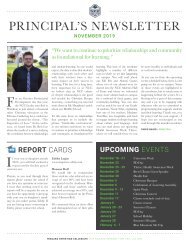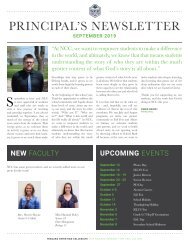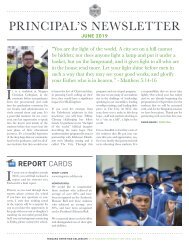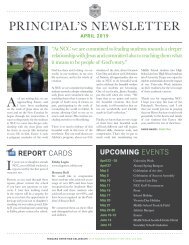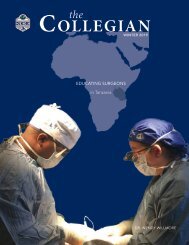Collegian Summer 2019
Create successful ePaper yourself
Turn your PDF publications into a flip-book with our unique Google optimized e-Paper software.
cont'd from pg. 3<br />
I roomed on the top floor of Belmont in<br />
one of the two rooms facing north. The<br />
window in the small room did not fit well<br />
in its frame; after a snowstorm, we could<br />
expect to see a small pile of snow on the<br />
floor.<br />
The school’s yearbook claims that I was<br />
“a lively resident of the fourth floor.” That<br />
claim could also have been made of my<br />
roommates - Arthur Heise and Clarence<br />
Climenhaga. Our combined liveliness one<br />
night resulted in one of my teeth getting<br />
chipped by a bottle thrown by Arthur from<br />
the bunk above where I lay. I did not have<br />
the tooth repaired until many years later,<br />
thus I carried for decades a too visible<br />
mark of my student life at NCC.<br />
A quartet that sang together for part of the<br />
1946-47 school year: left to right: Henry Regier,<br />
Morris Sider, John Reesor, Carl Heise<br />
Meals were adequate, even for hungry<br />
teenagers. Mary Lyons made basic foods<br />
enjoyable—as much as could be expected.<br />
I best remember a dish comprised<br />
mainly of hamburger and macaroni, but<br />
containing other sometimes unrecognizable<br />
ingredients (“leftovers” we thought),<br />
leading some of us to label the dish as<br />
Grand Old Mixture (or GOM for short).<br />
Apple butter was in good supply, being<br />
donated by someone in the Kitchener-Waterloo<br />
area. But its flavour was too much<br />
diminished by “filler,” which probably was<br />
pumpkin.<br />
As teenagers we were understandably<br />
interested in sports. But sports had their<br />
limitations. We had no gymnasium, thus<br />
sports were limited largely to those that<br />
could be played outdoors, mainly baseball<br />
and hockey, the latter in a scooped-out<br />
area shortly to the west of Belmont.<br />
Another limitation was the understanding<br />
that sports could not be extramural.<br />
During the winter of that year, the boys<br />
talked about playing a hockey game<br />
against Eden (a Mennonite high school in<br />
the Vineland area). I mentioned our talk to<br />
my father who (inadvertently, I think) mentioned<br />
it to a couple of other ministers.<br />
Soon two trustees arrived on campus to<br />
speak with me. There would be no game<br />
played with Eden, they declared, and I was<br />
not to spread such talk again.<br />
Not surprisingly, music was an important<br />
part of our student life. Quartets, trios, a<br />
mixed choir, four-part singing in chapel reflected<br />
the music heritage of the school’s<br />
constituencies. For part of a year I sang on<br />
a quartet that included Henry Regier.<br />
As my first-day experience suggests, NCC<br />
was a place where special relationships<br />
could be and often were formed, some of<br />
them eventually leading to marriage. But<br />
like sports, dating had limitations, such as<br />
no dating at movies or dances or other activities<br />
considered “worldly.” Where then<br />
could students date?<br />
Leone and my dating was something of<br />
a general pattern. Our first date was a<br />
bicycle ride around “the circle” near the<br />
school, with Leone sitting on the crossbar.<br />
Subsequently we dated by attending<br />
Bible conferences, revival meetings, and<br />
love feasts (special weekend services of<br />
the Brethren in Christ). For one date, we<br />
joined another couple (Arthur Heise and<br />
Verna Climenhaga, a faculty member) to<br />
travel to a Mennonite church east of Buffalo<br />
for a music programme given by Eastern<br />
Mennonite College (now University). There<br />
for the first time I heard the song “Going<br />
Morris and Leone hang school laundry in the<br />
early stage of their friendship<br />
Home” based on Antonin Dvorak’s New<br />
World Symphony. (Whenever I now listen<br />
to that symphony, I reflect on the loveliness<br />
and educational value of that date.)<br />
On our return to NCC, we bought two dozen<br />
donuts, thus adding to the sweetness of<br />
the occasion.<br />
When we returned to NCC in 1955 to join<br />
the staff, much had changed. Now the<br />
school could boast of having a new name,<br />
a gymnasium-auditorium, a grade 13, and<br />
extended sports activities which included<br />
a few extramural sports (and, yes, a game<br />
with Eden).<br />
What had not so much changed was the<br />
occasional need for disciplinary action, for<br />
which in my years as principal I had a major<br />
responsibility. We sent one student home<br />
for several days for playing pool in Fort<br />
Erie. When several girls left campus without<br />
permission, we gave each the penalty<br />
of writing one hundred times a promise<br />
never to repeat the offense. One student<br />
whom we expelled arrived home prior to<br />
my letter to his parents explaining the reasons<br />
for their son’s expulsion. The parents<br />
never received the letter.<br />
In one instance, disciplinary resolve quickly<br />
dissolved. I was standing in the vestibule<br />
of Belmont when a student, Ronald J. Sider<br />
(who later wrote Rich Christians in an<br />
Age of Hunger fame),<br />
cont'd on pg. 5<br />
NCC Gym 1957<br />
page 4











